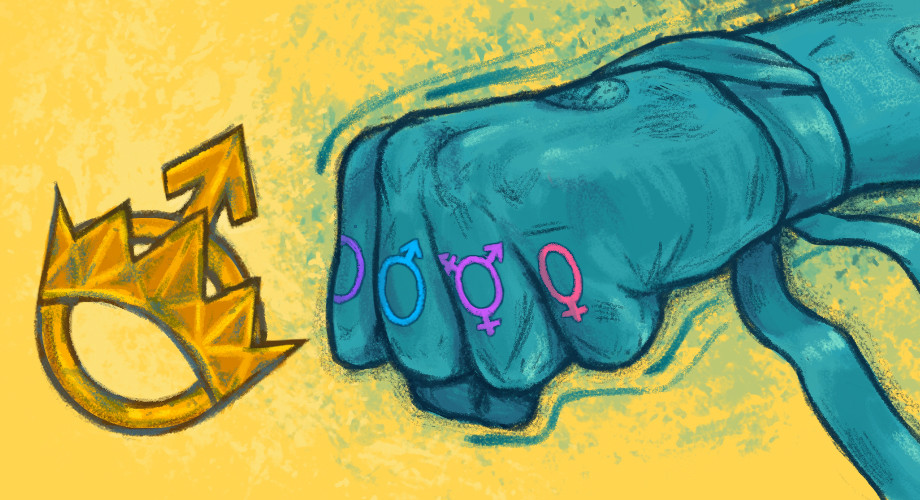In the Blog
Gender Division in the Movement

Illustration: Annette Elizabeth
Most recently I read two articles that spoke to the fact that once a movement focuses on one set of victims/survivors of sexual violence, that movement must be excluding the other victims/victims.
First, Angela Mullins wrote in Metro views on May 26th that she wanted to start a men’s movement. This was because she believed that the movement to end sexual violence and the newest campaign by the province of Ontario ‘It’s Never Okay’ excludes men and discounts the very real trauma and emotional upheaval men experience. The second example I would like to share before I get to my point is the #Sayhername / initiative from different activists all over the U.S. affiliated with Black Lives Matter. These activists have wanted to (and rightfully so) highlight the experiences of police brutality against Black women, Black mothers with children present and pregnant Black women. In my mind, it is clearly important that we measure a movement by who is included and who is excluded (and by who is doing the excluding and including) when we are centralizing marginalized voices. That is a must. And, as I am approaching these two examples with an acknowledged bias, I believe it is important to name all survivors of sexual violence – and to not exclude just because they may experience this violence less than the dominant group that does. That said, in our first article, Mullins describes that while women experience higher levels of assault that are often more violent in nature, “for those men who do become targets, being a victim is, I’d imagine, no less painful and no less soul-sapping.”
Of course, the experience of sexual violence is demeaning and painful. It is for anyone who has ever had to go through it. But Mullins gleans that since we exclude men in the narrative around sexual violence, since the “It’s Never Okay” public service announcement doesn’t picture men as victims, we should turn clearly gender-based violence into a genderless crime just because they experience it. On the contrary, it is still a culture of patriarchy that invisiblizes men’s experience of sexual violence. It is male police officers who erase their experience asking how a man could possibly get raped. It is a culture that says to men ‘you should want sex all the time’, ‘be a man’ and not be allowed to show emotion, which condones and exacerbates this violence when it’s reported by male victims. It isn’t solely the women’s movement or the movement to end sexual violence that has discounted the male experience of sexual assault. But, even in the example of #Sayhername where Black Lives Matters activists are making special moves to separate and acknowledge police brutality (which can especially include sexual violence against Black women and Trans bodies), herein lies another layer I would like to shine a light on.
It is a keen move on the part of BLM and #Sayhername organizers alike to include and highlight the existence of police brutality against Black women, which can also appear in the form of sexual violence against this community. #Sayhername knows that the statistics, while less reported for Black women who experience police brutality, are no less tragic or oppressive. We can even acknowledge that Black women will experience violence, racism, and sexism when they are targeted by police. Clearly, survivors of sexual violence, victims of oppression in a movement need to be named and recognized. It is so important to acknowledge the victims/survivors of this violence in these contexts but the focus on survivors mustn’t stop there. We need to focus on the perpetrators and why this violence happens to all people and particularly Black and Indigenous women, and Trans bodies more than other folks. We aren’t competing about who experiences violence, are we? (And, I don’t believe this is the case at all in the movements to end sexual violence or BLM activism). We are trying to stop a culture of violence that thinks these bodies are more expendable. We are trying to stop a system that permits this violence for its own purposes; of power mongering and greed. Clearly stated, I think Mullin’s article simplifies the concept and purpose of the “It’s Never Okay”s campaign public service announcement. It is important to highlight all survivors - you don’t need a men’s movement to do that. There are countless spaces where male survivors and allies alike can share space to help stop violence in our communities. Maybe we should take a lesson from #Sayhername – Black Lives Matters activists in Baltimore, Chicago, Miami, Los Angeles.
Our movements are about victims of violent oppression and acknowledging the most oppressed among us. And, they are also about the root cause of why this violence happens, acknowledgement of the history of that violence, the struggles and people who are fighting to resist that violence and the hope we create for a better world.
Additional Resources for #SayHerName:
#SayHerName Shows Black Women Face Police Violence, Too—and Pregnancy and Motherhood Are No Refuge
Photos Of Women Protesting Topless Removed From Social Media
#SayHerName: How black liberation history teaches us to forget black women
‘Say Her Name’ Turns Spotlight on Black Women and Girls Killed by Police



